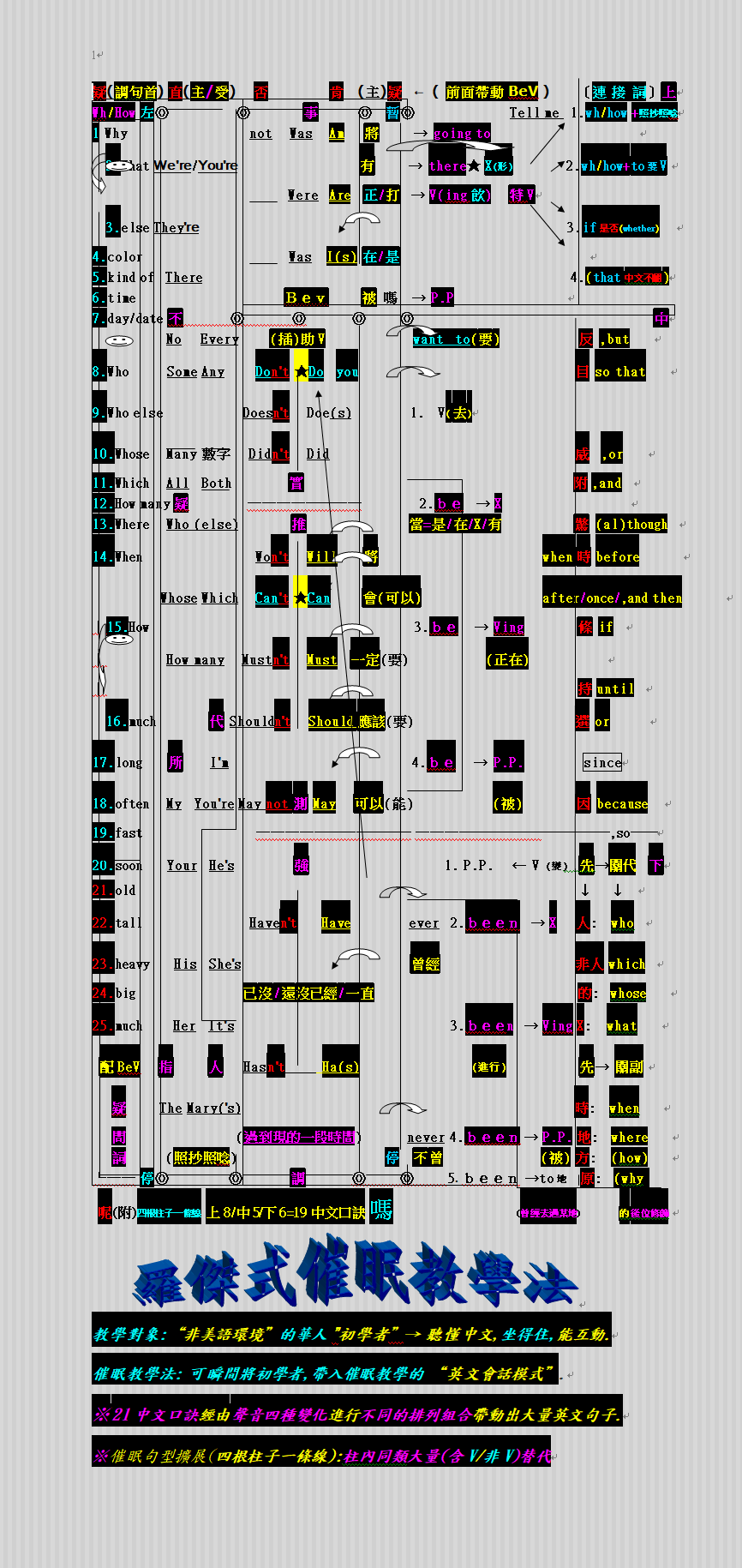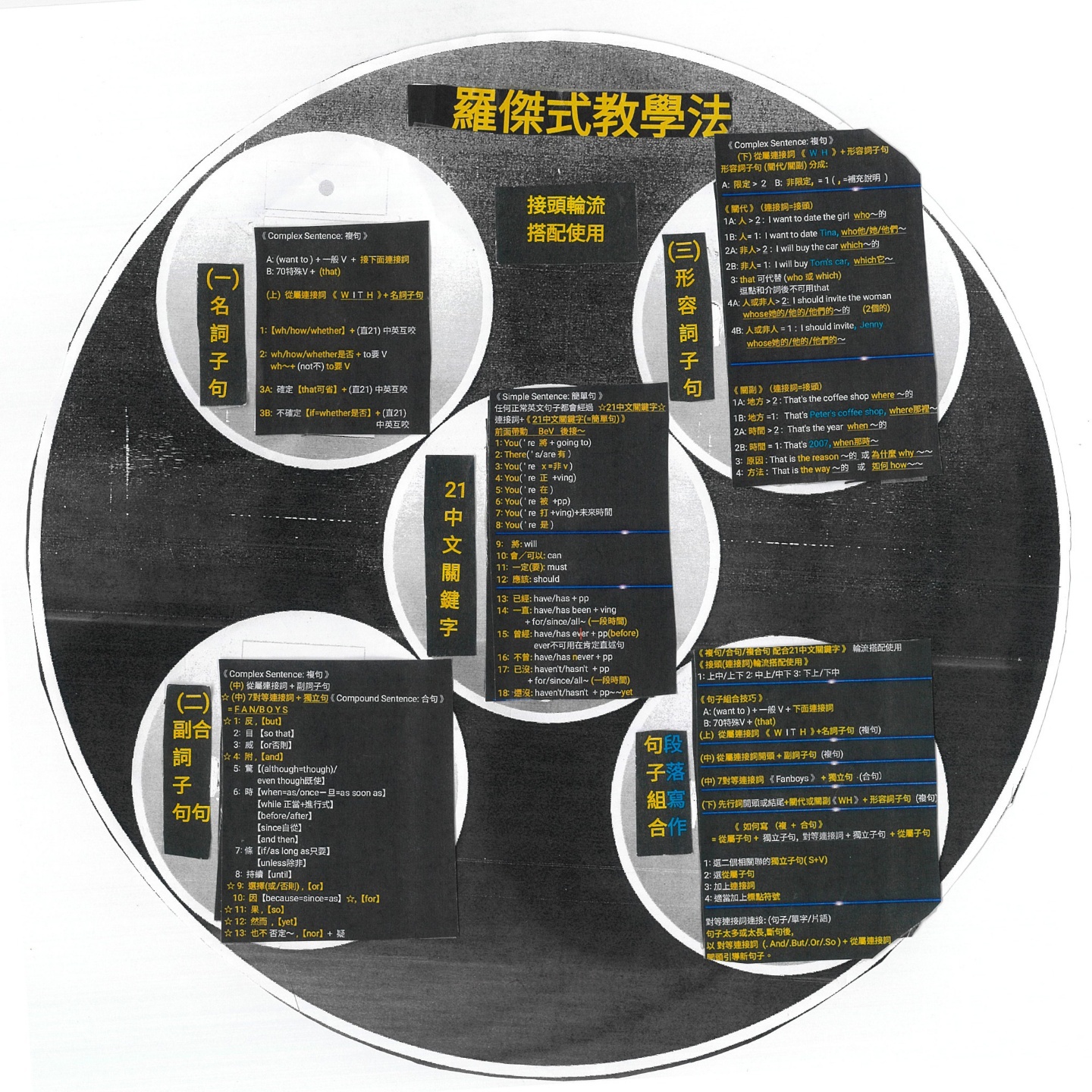【羅傑式教學法】
《 進階版課程 》
《進階版 輔助教材選單》
【進階版教學內容】
接頭(連接詞)
+
子句
= 句子組合 > 段落寫作
![]()
邊連接詞: 上(名)/中(副)/下(形)
【全方位完整直覺催眠句型】
【1單字 → 100句子 】

![]()

<1️⃣>
子句分成四種:
A: Simple:簡單句(獨立句: S+V)
(單元一)~~(單元四)
B: Complex:複句
名詞子句/副詞子句/形容詞子
主要子句 = 獨立句:S+V
1: 主要子句 + 名詞子句
2: 主要子句 + 副詞子句
3: 主要子句 + 形容詞子
‘’+‘’ = 接頭(連接詞)
C: Compound:合句
獨立子句+ ,+ FANBOYS +獨立子句
7組(本尊)對等連接詞
D: Compound-Complex: 複合句
= 複句+合句 (句子組合)
![]()
<2️⃣>
A: Subordinating conjunction
(從屬連接詞)
B: coordinating conjunction
(對等連接詞= , fanboys )
C: ;Adverbial conjunction,
(副詞連接詞:從屬連接詞
和對等連接詞的分身)
D: Semicolon ‘’ ; ‘’
(分號: 對等連接詞的分身)
![]()
<3️⃣>
《任何正常英文句子都會經過》
(21個中文關鍵字)
☆ 連接詞 + 子句
=(一件事內容=主詞+21關鍵字)
配合4種接頭(連接詞):從屬連接詞/
對等連接詞/副詞連接詞/分號;/
(配合:分詞構句和不定詞片語)
以下為主要子句
+ (上/中/下 ) 複句
(Complex Sentence)
複句: 包括一個獨立子句 (主要子
句) + ≥ 1 從屬子句所組合。
| 主要子句【連接詞】+ (可獨立=母) |
上層名詞子句(間接) 中層為副詞子句 下層為形容詞子句 合句: 2獨立子句結合 (無法獨立=子) |
《重點:掌握連接詞和後面主詞》
![]()
⛔️⛔️⛔️⛔️ over ⛔️⛔️⛔️⛔️
![]()
☆☆☆☆☆☆☆☆☆☆☆☆☆
【快速總覽】
把子句改成不定詞片語 或
分詞構句 (分詞片語)
☆+快速記憶法☆
☆☆☆☆☆☆☆☆☆☆☆☆☆
1:名詞子句: 疑連wh/how + (主+助V) + V
( 把V改成不定詞片語: to v )
2:形容詞子句: 關代 (連wh/how)OOOOO
3:副詞子句: 7從屬 (連+主) + VOOOOO
4:合句(獨立子句): 7對等 (連+主) + VO
把V改成分詞構句: Ving (主動/進行)
p.p.(被動/完成)
![]()
⛔️⛔️⛔️⛔️ over ⛔️⛔️⛔️⛔️
![]()

☆☆☆☆☆☆☆☆☆☆☆☆☆
☆☆☆☆☆☆☆☆☆☆☆☆☆
【(ㄧ) 名詞子句】
☆☆☆☆☆☆☆☆☆☆☆☆☆
☆☆☆☆☆☆☆☆☆☆☆☆☆
<1️⃣>
連接詞=wh/how 疑問詞
《間接問句 : 快速口訣記憶法 》
間接問句:【接頭=wh/how】
調到水管 (句子) 中間
【接頭】後面照抄照唸
(接頭後面以直述句表示:中英互咬)
= 主要子句 +【接頭wh/how 】
+ 名詞子句 (直21) 中英互咬
![]()
<2️⃣>
【 間接問句 】
《 接頭 (wh/how) 替代練習》
主要子句
(Can/Could/Would) you tell me/
Please ask +人/I (don't) know/Do
you know/I'm (not) sure/Are you
sure/I wonder想知道/
☆I don't care/Do you care
+【接頭 wh/how】+ (直述句:中英
互咬)
+ wh/how~~ (名詞子句)
或 + wh/how~~ 《名詞片語:
(not不) to要 v》
![]()
<3️⃣>
名詞子句前面的連接詞包括:
☆+快速記憶法☆
《 W I T H 》
1. wh/how
2A.確定(that可省)+(直21) 中英互咬
I know (that省) you want to order raw fish.
2B.不確定if=whether是否+ (直21)
中英互咬
I don't know if/whether you want
to order raw fish.
I don't care if you're rich or poor,
educated or uneducated,
beautiful or ugly.
![]()
<4️⃣>
《練習ㄧ》
☆ 善用【疑問副詞】大量替代
Please tell me 【why/where/
when/what/what time/ how/
how long/ how often】you want
to teach.
☆why 和 if 後面不可接不定詞片語
【 含以上共(十一組)疑問副詞 】
what day(date) / how fast多快
(速度) / how soon多快(時間)/
how (old/tall/heavy/big/much)
(年齡/身高/體重/大小/價錢)
為非V(形容詞)要找BeV
![]()
<5️⃣>
《練習二》
善用【疑問詞當主詞/受詞】 替代
Tell me [受who/who else/whose
kid/which girl/what/how many
people]
(主you) want to teach.
Tell me [主who/who else/whose
kid/which girl/ how many people]
want(s) to teach (受you) .
![]()
<6️⃣>
【十二組疑問詞當主詞或受詞】
Who(受) do you like?
Who(主) likes you?
[人/非人]
who/ who (else還有)/whose + n
which + n /how many + 可數ns
[非人]
how much + 不可數n/
what/ what (else)/
what color(size)/
what kind of + n/
☆ which (how many)
of 之中 the boys (your kids, them)
![]()
⛔️⛔️⛔️⛔️ over ⛔️⛔️⛔️⛔️
![]()
☆☆☆☆☆☆☆☆☆☆☆☆☆
名詞子句 改成 名詞(不定詞)片語
☆+快速記憶法☆
☆☆☆☆☆☆☆☆☆☆☆☆☆
主要子句 + wh/how +【 S + 助V
(should/can/could/will)】+ V
主要子句 + wh/how +【 S + 助V
(should/can/could/will) 】+ V
把 S + 助V (should/can/could/will) 刪掉
再把V 改成 to V= wh/how/whether+ to V
除 why 和 if 外
<1️⃣>
1: <前後主詞必須同ㄧ人> 或
2:<前句受詞和後句主詞同一人>
才能改成名詞片語(不定詞片語)
("受詞" 做後面動作)
否定不定詞片語: wh + (not不)to V
![]()
<2️⃣>
Please tell me受 what I主 should
order. (me受詞:做後面動作)
= Please tell me what to order.
可改成不定詞片語 (前句受詞和後句
主詞同一人)
Please ask Tina受 what time
she主 should leave.
=Please ask Tina受 what time
to leave.
I don't know whether I should stay.
否定: wh~+ (not不) to要 V
I know what I should
do and what I should (not) do.
![]()
A: He discovered how (he could)
open(v) the safe.
B: I'm not sure what (I should)
buy(v).
C: Tina didn't know where (she
should) put(v) the computer in
the office.
D: Tell me how (I should) fix(v)
the bike.
E: I don't know when (I should)
hand in(v) my report
F: Tom is not sure whether (he
should) retire(v) .
G: I have decided who I will invite.
H: I'm not sure how much money
I should borrow.
![]()
<3️⃣>
【 名詞片語 (不定詞) 直接練習】
learn (English)/work/eat/live/
buy/rest/drive/borrow/park/
retire/invite/date/fix/pay/invest/
order/
![]()
⛔️⛔️⛔️⛔️ over ⛔️⛔️⛔️⛔️
![]()
☆☆☆☆☆☆☆☆☆☆☆☆☆
《名詞雙重修飾》
☆☆☆☆☆☆☆☆☆☆☆☆☆
1: 前位修飾: A of B
2: 後位修飾: ~~的
[ A of(之中/介) B ] + [ ~~的 ]
(由後往前翻)
註:A 為主詞
(二個前位修飾+ㄧ個後位修飾)
例: (可用在句子擴展)
Most of之中(句首)
The famous(前) singers
invited to the concert的(後)
are from America.
(由大而小 ; 由籠統到具體)
(由後往前翻:後位修飾)
英文寫作重要元素,英文的思考模式
《後句說明前句》
☆☆☆☆☆☆☆☆☆☆☆☆☆
☆☆☆☆☆☆☆☆☆☆☆☆☆
<1️⃣>
〈前位修飾〉
《數量不定代名詞》
《 A 部份 of(之中/的) B 群體 》
由後往前翻
註: 善用【當主詞 或 受詞】
《以下數量不定代名詞分成三組》
第一組: 數量不定代名詞O
第二組 : 百分比OOOOOO
第三組 : 分數 OOOOOO
![]()
<2️⃣>
《 A 部份 of(之中/的) B 群體 》
由後往前翻
不理不可數 (ㄧ律用單數)
☆只鎖定 可數(有單複數) 之分☆
![]()
<3️⃣>
《B群體為可數名詞時: 如何決定
V 是單數或複數》
第一組(找前面) A(主詞):
鎖定 〈A數量不定代名詞〉
(如果 A 是單數, 則V就是單數)
(如果 A 是複數, 則V就是複數)
![]()
第二組: 百分比 和
第三組: 分數 (找後面) B :
鎖定 〈B群體 可數名詞〉
( 如果B是單數, 則V就是單數 )
( 如果B是複數, 則V就是複數 )
![]()
<4️⃣>
【 第 1 組 《可數》 】
以下為《可數》數量不定代名詞
《 (找前面) A(主詞) 》
<決定 V 是單數或複數>
![]()
![]()
註:Each(=Every one)/Either/
Neither→視為單數(中文有‘’一‘’)
![]()
=1: 《A》 One/Each每一 of之中
《B》 the(這些/那些 ) + Ns
所有格(~的 )
受格:us/you/them(~們 )
One/Each of my students has a
bike.
![]()
=2者: 《A》 Both二者都
Either任一人 of之中
Neither無一人
《B》 the(這些/那些 ) + Ns
所有格(~的 )
受格:us/you/them(~們 )
Both of them are sleeping.
Either of them(=2) is very smart.
Neither of them(=2) speaks
English.
![]()
≥ 3者: 《A》 All全部
Any任一人 of之中
None無一人
Many/Most/
Some(A fewㄧ些)
several幾個
☆Few很少
《B》 the(這些/那些 ) + Ns
所有格(~的 )
受格:us/you/them(~們 )
All of my kids are here.
I didn't read any of these(≧3)
books.
Is (Are) any of your coworkers
married?
(any of 接複數名詞時,則V可以用
單數V或複數V).
None of the boys(≧3) are shy.
Many/Most/Some of
my friends live overseas.
例:(以上可當主詞或受詞)
I know you can help(v) some of
the girls(受).
I know some of the girls(主) can
help you.
![]()
![]()
【第 1 組 《不可數》】
<1️⃣>
(不可數 名詞本身 和後面的 動詞
ㄧ律用單數)
不可數名詞:無法用 one,two…來數,
前不可加 a/an, 字尾不可加 "s”
![]()
<2️⃣>
《不可數名詞包含以下》
【 液 體】
《water/tea/juice/milk
/coffee/rain 雨》
【 氣 體】
《air 空氣》
【 專有 名詞】
English/Taipei/
Mary
【食物(肉類)】
《meat 肉/beef 牛
肉/pork 豬肉/chicken 雞肉/fish 魚
肉》bread 麵包(粉)/rice 飯(砬)
【 工作 】
《 work 工作/
homework 作業/housework 家事
【 抽象 名詞】
(看不到;摸不到)】
省下《time/money(時間就是金
錢)/trouble 麻煩》
![]()
<3️⃣>
不可數名詞表示明確的定量時, 以
單位來表示,而這些單位是可數名詞,
有單,複數的變化.
a pound 磅 of 的 beef
two kilos
公斤 of pork
three bottles of juice
four cups of coffee
five glasses
of milk
six buckets 桶 of water
seven cans 罐 of fish
eight
pieces張 of paper
![]()
<4️⃣>
《不可數名詞的不定代名詞》
All/Much/Most/Some(A little)/
Any ☆A lot of= Much
☆Little很少
![]()
<5️⃣>
不可數名詞本身 和後面的 動詞 ㄧ
律用單數)
1: All of (my money is) gone.
2: Most of (the meat was) fresh.
3: Some of (my housework was)
done.
4: Much of the milk in the fridge冰
箱 is bad. (由大而小 ; 由籠統到具
體)
5: Any of (the chicken is)
delicious.
![]()
⛔️⛔️⛔️⛔️ over ⛔️⛔️⛔️⛔️
![]()
【 第 2 組 】
《第二組: 百分之…(符號為%)》
《 A %~ (of(的/之中) B 群體 》
《第三組分數: "幾分之幾" 》
(第二, 三組用法ㄧ樣)
![]()
<1️⃣>
第二組: 百分比 和
第三組: 分數 (找後面) B :
鎖定 〈B群體 可數名詞〉
( 如果B是單數, 則V就是單數 )
( 如果B是複數, 則V就是複數)
![]()
《百分之…的寫法》
25%=25 percent=twent-five
percent
ex:
1: 20% of (the book was)
damaged受損.
2: 20% of (the books were)
damaged.
3: 65 percent of (children play)
computer games.
4: Sixty percent of (the members
are) against the system制度.
5: Forty of (the building is) for
rent出租.(for sale出售)
6: 20% of (the country has) air
pollution汚染.
7: 50% of (the chips晶片 are)
made inTaiwn.
8: 30% of (the cars are) imported
進口 from Japan.
9: 47% of (the city is) polluted被汚
染.
10: ☆About seventy percent
(two thirds) of the population
人口 in China are farmers.
人口的百分之幾或幾分之幾時,V動詞用複數
![]()
⛔️⛔️⛔️⛔️ over ⛔️⛔️⛔️⛔️
![]()
【 第 3 組 】
《 第三組分數: "幾分之幾" 》
《A ~分之~ (of(的/之中)
B 群體 》
《和第二組: 百分之…用法ㄧ樣》
![]()
<1️⃣>
第三組: 分數 (找後面) B :
鎖定 〈B群體 可數名詞〉
( 如果B是單數, 則V就是單數 )
( 如果B是複數, 則V就是複數 )
![]()
<2️⃣>
英文分數的唸法都是
先分子,後分母.
分子為基數, 分母為序數.
子1,2 3/母第1,2,3
分子>1時, 分母加"s".
![]()
<3️⃣>
有兩個分數比較特別分別為:
1/2: half
1/4: a quarter
ex:
1/3: one third
2/3: two thirds
3/4: three fourths
4/5: four fifths
7/10: seven tenths
![]()
1: Half of (my friends are)
Americans.
2: A quarter of (the students are)
under 17.
3: Two thirds of (the book was)
burned.
4: Two thirds of (the books were)
burned.
5: Half of (the dorm宿舍 is)
air-conditioned有空調設備.
6: One seventh of (the teachers
are) retired退休.
7: One fourth of (the house has)
been redecorated被重新裝潢.
8: Three fourths of (my
coworkers同事 are) married.
9: Three fourths of (the hotel
was) renovated被翻新.
10: One tenths of (the employees
雇員don't) have health insurance健
保.
11: A quarter of (the workers
have) got a raise加薪.
![]()
⛔️⛔️⛔️ over ⛔️⛔️⛔️
![]()
《 集合名詞 》
在句子中表示一個 整體,後面的動
詞用 單數, 而如果該名詞在句子中
表示 成員 , 後動詞則用 複數.
<例>
His family家庭 is rich and
powerful in this country.
<整體>
Lucy's family家人 were happily
hugging and kissing their
missing girl after they found her.
<成員>
![]()
百分比 和 分數 of(的/之中) + the
〈可數集合名詞 ( 成員)〉+ 複數V
例:
1: Half of the (tour) group 旅行團
are Taiwanese.
2: Two thirds of the team團隊 are
training. (單: team member)
3: One third of my class are absent.
4: 10% of the crew 組員 speak
perfect English.
(單: crew member)
5: 70% of the compan staff員工
are working very hard.
(單: staff member)
6: 90% of the police警方 are
well- trained.
(單: policeman/policewoman)
(police officer)
7: One seventh of the audience
(觀/聽 眾) are female.
(單: viewer/listener)
8: A quarter of the committee
委員會 are professors and lawyers.
(單: committee member)
9: Half (All) of Jenny's family
are doctors.
(單: family member)
![]()
⛔️⛔️⛔️⛔️ over ⛔️⛔️⛔️⛔️
![]()
《 ~~的 (後位修飾)》
打破中文排列,造成中英互咬。最典
型的就是後位修飾,它和中文排列剛
好倒過來。
![]()
<1️⃣>
[N + (~~的)] 後位修飾
(由Bev 簡化而來)
《人/非人(當主詞或受詞)》
+ 後位修飾替代
![]()
<2️⃣>
1: 地方副詞
2: 地方片語
3: 介詞片語
4: 分詞片語: (ving/p.p.)
5: 形容詞片語: (形容詞+介詞)
6: 形容詞子句(~~的)
7: 同位語(是)
,one of the most important
writers in Taiwan,
8: in穿 + 服飾/顏色
with戴 + 配件/with有 + 外貌
![]()
<3️⃣>
由後往前翻
(The girl主)
1: upstairs (~~的)
2: nexr door (~~的)
3: on vacation (~~的)
4: sleeping downstairs(~~的)
hired yesterday (~~的)
5: interested in music (~~的)
6: who often shops here (~~的)
7: 是=my classmate ,
8: in a white skirt/in white(~~的)
with glasses/with long hair (的)
( can help me受).
![]()
<4️⃣>
(主詞受詞對調)
(I主 can help ) (the girl受)+ 後
位修飾
<5️⃣>
《 前位+後位 雙重修飾 》
I know you want to teach some
of之中 the girls interested in
English的. (由後往前翻)
⛔️⛔️⛔️⛔️ over ⛔️⛔️⛔️⛔️

☆☆☆☆☆☆☆☆☆☆☆☆☆
☆☆☆☆☆☆☆☆☆☆☆☆☆
【(二) 副詞子句/合句】
☆☆☆☆☆☆☆☆☆☆☆☆☆
☆☆☆☆☆☆☆☆☆☆☆☆☆
A: 從屬連接詞連接二個子句,可放
句中,或 句子開頭.
1: ___子句___ [ 連接詞 ]___子句____
2: [ 連接詞 ] ___子句__ , __子句__
![]()
B: Compound合句=獨立子句
= (共7組對等連接詞 )
___獨句__ , Fanboys ___獨句__
![]()
☆ 從屬子句和獨立子句前面的連
接詞
包括以下:
《從屬連接詞/對等連接詞:快速
口訣記憶法》
(原因:地主要漲租金,對方不接受)
結果:地主:O
⬇
☆1:反>, but
I'm very busy,【but】I can
help you now.
![]()
2:目>so that
You have to save money 【so
that】you can buy a house.
![]()
3:威>or 否則:祈使句(原V開頭)
1: Work hard【or】I'll fire you.
(負面)
2: Work hard【and那麼】I'll
hire you. (正面)
![]()
☆4:附> ,and
You should give Peter some
money,【 and】you should
find a good job for him.
![]()
5:驚>although~~~, ~~~still~~
【Although=Though/Even
though既使】I was very tired,
I still couldn't fall asleep.
![]()
6:時>
1:【When=As/Once ㄧ旦=As
soon as】you finish your
work, you must take a
shower.
2: My girlfriend came【while 正
當+進行式】I was taking a
shower.
3:【 Before/After】 I have
dinner, I will send you a
message(text).
4: Kevin has been_一直當 a
teacher 【since自從】2015.
5: I met her in downtown
Taipei, 【and then=then】
we had dinner together.
![]()
7:條>if
1:【If/As long as只要】 you
work out every day, you'll
stay healthy.
2: I can't help you【unless除 非】you
work hard.
![]()
8: 持續>until
I may stay here【until】 you come back.
![]()
☆9:選擇 (或/否則) ,or
1: You can work in Taiwan,
【or】you can study abroad.
2: Work hard, or I will fire you.
![]()
10:因>because ☆ , for
1:【Because/Since/As】Jenny
was quite depressed, she
ran away from home.
2: Jenny didn't show up at the
meeting, 【for】she had a
bad cold.
![]()
☆11:果> , so
The kid didn't do his
homework, 【so】his mother
was super angry .
![]()
☆12:然而 (對照) > , yet
Wendy enjoys going shopping,
【yet=while】her husband
prefers to watch baseball
games at home.
![]()
☆13:也不> 否定~, nor+疑問
Tina doesn't like sea, nor do I.
![]()
![]()
<1️⃣>
☆☆☆☆☆☆☆☆☆☆☆☆☆
《副詞子句 改成 (分詞片語)》
☆+快速記憶法☆
☆☆☆☆☆☆☆☆☆☆☆☆☆
《分詞構句 (分詞片語)》
由三種子句改變而來
第一種出現在句首由副詞子句簡化
而來。
如果副詞子句符合二條件就可簡化
A. 它是時間/原因/條件
副詞子句
B.副詞子句和主要子句主詞相同
![]()
<☆2️⃣>
子句改成 分詞構句 的二個步驟
1: 把(從屬連接詞和後面的主詞)同
時省略
2:將副詞子句的動詞改成分詞構句
![]()
<☆3️⃣>
副詞子句沒未來式:以現在代未來
副詞子句有以下時態
1:現在式 2: 過去式 3: 完成式
現在式和過去式改成分詞構句
主動或進行: 改成Ving
被動: 改成 p.p.(被)
進行式被動
改成 being p.p.(正在被)
![]()
<☆4️⃣>
完成式 改成分詞構句
從屬連接詞 + 主詞 ~(省略)
主動: having pp(已經)
被動: having been pp(已經被)
![]()
<5️⃣>
《副詞子句改成分詞構句應注意》
1: 分詞構句否定在前面加 "not"
2: before/after控制時間發生先後
不可輕易刪。除非(前後二句有明顯
先後關係連接詞才可省)
3: 分詞構句裡要有分詞 (ving或pp)
如果沒有要加 Being, 否則就沒
分詞)
![]()
《把以下副詞子句改成分詞構句》
《練習一》
《條件副詞子句》
(if 連接詞不要省否則會被誤
認是because)
1: If you do exercise every day,
you'll stay healthy.
If doing exercise every day,
you'll ]stay healthy.
2: If you finish your work today,
you can take a vacation.
If finishing your work today,
you can take a vacation.
3: If you run a red light, you will
get a ticket.
If running a red light, you will
get a ticket.
![]()
《原因副詞子句》
(because=as=since)
(連接詞要省可被理解)
1: (Because=Since=As) he was
late, he drove to work.
Being late, he drove to work.
(要加Being,否則就沒分詞了)
2: Because Jenny had to get up
early, she went to bed at 9:30.
Having to get up early, Jenny
went to bed at 9:30.
(名詞在前, 代名詞在後, 改成分詞構句時, 必
須對調)
3: As the young man was hit (pp)
by a car, he was sent to hospital.
Hit(pp) by a car, the young man
was sent to hospital.
4: Since Tom was being
punished, he was crying loudly.
Being punished, Tom was
crying loudly .
<進行式被動(正在被) being 不可省>
5: Because Lily is a single
mother, she can’t quit her job
Being a single mother, Lily
can't quit her job.
(要加Being,否則沒分詞)
6: As Tina didn't know what to
do, she began to cry.
Not knowing what to do, Tina
began to cry.
![]()
《時間副詞子句》
可省 (可不省) / 簡潔可省最好
(前後二句有明顯先後關係連接詞才可省)
before/after控制時間發生先後不可輕易省
【when=while正當】
1: When I played in the park, I
lost my purse.
Playing in the park, I lost my
purse.
2: (Before/After) I had dinner,
I took a shower.
(Before/After) having dinner,
I took a shower.
before/after控制時間發生先後不可輕易刪
3: After she put on her makeup,
she looked good.
Putting on her makeup, she
looked good.
(前後二句有明顯先後關係連接詞可省)
4: After he had been arrested
by the police, he was taken to jail.
(過去二個動作先發生用過去完成式後發生
用過去式;也可以前後句都用過去式)
Having been arrested by the
police, he was taken to jail.
(前後二句有明顯先後關係連接詞可省)
![]()
⛔️⛔️⛔️⛔️ over ⛔️⛔️⛔️⛔️
![]()

☆☆☆☆☆☆☆☆☆☆☆☆☆
☆☆☆☆☆☆☆☆☆☆☆☆☆
【(三)形容詞(關係)子句】
☆+快速記憶法☆
☆☆☆☆☆☆☆☆☆☆☆☆☆
☆☆☆☆☆☆☆☆☆☆☆☆☆
《 W H 》
限定用法: 關代/關副~的
非限定用法:,關代/,關副
例:限定和非限定用法的比較
A: Tony has a girlfriend
who lives overseas.的
《限定用法>1 (不只1個)》:
<不只一個, 真是花心! >
B: Tony has a girlfriend ,
who她 lives overseas.
《非限定用法=1 (只有1個)》:
逗點 ‘’ , ‘’ = (補充說明ㄧ下)
![]()
<1️⃣>
《關代》
關代當受詞可省略
I know the girl (who省) you met 的
關代當主詞可省略改成分詞片語
(Ving/P.P.)
![]()
<2️⃣>
《關係子句前面的連接詞(關代/關副)》
包括以下:
形容詞子句有限定和非限定之分
1A: 先行詞人 > 1+【who】~~的
(形容詞子句:跟屁蟲)
限定用法~~的 (使其明確) :
I'm going to date (the girl 不明確)
【who】lives near here的.
1B: 先行詞人, = 1+【who他/她 /
他們】
非限定用法 (補充說明) :
I'm going to date (Tina 明確),
【who她】lives near here.
明確=1:非限定用法, 先行詞後打一個逗點
(,補充說明)= 順便提一下)
![]()
2A: 先行詞非人> 1+【which】~的
(形容詞子句:跟屁蟲)
限定用法~~的 (使其明確) :
I have bought (the car 不明確)
which is imported from Japan的.
2B: 先行詞非人, = 1+【which它】
非定用法:(補充說明) :
I have bought (Tom's car 明確),
which它 is imported from Japan.
![]()
3:that可代替 (上二句who和which)
逗點和介詞後不可用that
![]()
4A : 先行詞人或非人> 1+
【whose她的/他的/他們的】~~的
(2個的)
(形容詞子句:跟屁蟲)
限定用法~~的 (使其明確) :
I know the woman【whose她的】
husband is a doctor的 .(2個的)
4B: 先行詞人或非人, = 1 +
【whose她的】
非定用法:(補充說明) :
I know Jenny,【whose她的】
husband is a doctor .(1個的)
![]()
5: 沒先行詞 + 【what】~~的
I liked (the meal which=) what
you cooked的.
![]()
《關副》
有限定和非限定之分和上面的關代
用法一樣
1A: where:That's the coffee
shop(地方) 【where】 I met
Jenny.的
1B: That's Peter's coffee shop,
【where那裡】I met Jenny.
![]()
2A: when:That's the year(時間)
【when】we got married.的
2B: That's 2007, 【when那時】
we got married.
![]()
3: why: the reason why (只能選一個)
That's【why為什麼】I got fired.
=That's the reason(原因) I got
fired.的
![]()
4: how: the way how(只能選一個)
That's【how如何】 I learn
English.
That's the way(方法) I learn
English.的
![]()
![]()
☆☆☆☆☆☆☆☆☆☆☆☆☆
《形容詞子句改 分詞片語》
☆+快速記憶法☆
☆☆☆☆☆☆☆☆☆☆☆☆☆
<1️⃣>
《分詞構句 (分詞片語)》
第二種出現在名詞(先行詞)後由形
容詞子句 (~~的) 簡化而來
符合二條件就可簡化
A.形容詞子句(~~的)
B.連接詞(=關代)本身是主詞
![]()
<2️⃣>
子句改成分詞片語的二個步驟
1: 把關代省略
2: 將關係子句的動詞改成分詞
A: Ving (表示主動或進行)
B: pp (表示被動)
C: being pp(進行式被動:正在被)
D: bev + 介詞片語或形容詞片語時
‘’bev‘’ 省略
![]()
關係子句改成分詞構句練習
1: The people who are at the
back can't hear clearly.
2: I will buy some gifts for those
who are friendly to me.
3: The girl who was bullied last
week has decided to quit.
4: The house which wasbuilt 20
years ago still looks beautiful.
5: The girl who is dancing with
Tom is very fashionable.
6: Students who hand handing
in their homework late will be
punished.
7: The house which is being sold
is super expensive.
8: The model who performed
performing on TV yesterday is
my girlfriend.
9: I'm going to date the girl who
lives living near here。
![]()
⛔️⛔️⛔️ over ⛔️⛔️⛔️
![]()

☆☆☆☆☆☆☆☆☆☆☆☆☆
☆☆☆☆☆☆☆☆☆☆☆☆☆
《(四)合句 Compound Sentence》
☆+快速記憶法☆
☆☆☆☆☆☆☆☆☆☆☆☆☆
☆☆☆☆☆☆☆☆☆☆☆☆☆
<1️⃣>
獨立子句前面7組(本尊)對等連接詞
包括以下:
For And Nor But Or Yet So
= FAN/BOYS(本尊)
獨立子句+ ,+ FANBOYS +獨立子句
![]()
<2️⃣>
(and/but)or(for/so)
(用的最多)
and /but /or 除了可連接子句外,
也可連接單字/片語(前後 詞類 和
時態 要對稱)
![]()
<3️⃣>
等連接詞連接二個子句(S+V) 前面
需要加逗點 ‘’,‘’
但連接二個單字或片語則不需要
![]()
1: 附加:,and 和(而且/而)然後
獨立子句, and 獨立子句(S+V)
1:The TV program is
entertaining, and it's educational.
2: We spent our holidays at the
seaside, and we enjoyed the
beautiful views.
![]()
and 連接二個單字/或片語時前後
詞類 和 時態 要對稱.
連接二個(to v) 時後面的 to 可省略.
連接動詞
1: Don't drink and drive.
2: I helped her do her housework
and gave her a lift to work.
3: John likes to take photos and
(to省) go hiking.
連接名詞
I'll buy a notebook and a
cellphone.
連接形容詞
My ex前任 is selfish, stingy,
and irresponsible.
連接副詞
I drive slowly and carefully.
連接片語
Tom is out of love and out of
work.
![]()
2:反義21關鍵字(或語氣轉折對照):
, but 但是
獨立子句, but 獨立子句(S+V)
1: The movie is great, but the
theater is dirty .
2: I can sing and dance, but I
can't do magic tricks.
![]()
but 連接二個單字/或片語時前後 詞
類 和 時態 要對稱.
連接形容詞
1: The man is rich but unhappy.
2: The food is nice but expensive.
連接片語
The man was in love but in debt.
![]()
3: 選擇:, or (或/否則)
獨立子句, or 獨立子句(S+V)
1: You can find a job in Taiwan,
or you can study abroad.
2: Work hard, or I will fire you.
![]()
or 連接二個單字/或片語時前後 詞
類 和 時態 要對稱.
連接動詞
I don't know whether Tina
stayed or left.
連接名詞
Would you like to order beef or
raw fish?
連接形容詞
Is the car cheap or expensive?
連接副詞
Does Peter drive carefully or
carelessly?
Will your friend come now or
later?
連接片語
You can put the book on the
desk or in the drawer.
![]()
4: 結果 :, so 所以
獨立子句, so 獨立子句(S+V)
1: The weather was bad, so I
stayed indoors all day.
2: Ken broke his leg, so he
couldn’t go outside.
3: I was tired, so I took a nap.
![]()
5: 原因:, for 因為
獨立子句, for 獨立子句(S+V)
1: Jenny didn't show up at the
meeting, for she had a bad cold.
2: She was angry, for her
husband forgot her birthday.
![]()
6: 然而(令人驚訝的對照 ):, yet
獨立子句, yet 獨立子句(S+V)
近似 but/while
1: The test was easy, yet Mike
didn’t pass it.
2: Jenny is an introvert內向的人,
yet she likes parties.
3: He's not rich, yet he drives a
Ferrari.
![]()
7:也不 (少用) > 否定~, nor+疑問
Tina doesn't like sea, nor do I.
![]()
☆☆☆☆☆☆☆☆☆☆☆☆☆
《分詞構句 (分詞片語)》
☆+快速記憶法☆
☆☆☆☆☆☆☆☆☆☆☆☆☆
<1️⃣>
第三種出現在ㄧ個句子後是由含有
and對等連接詞改變而來。
符合三條件就可簡化
A.含有and 的對等子句
B.前後二個主詞相同
C.前後二個動詞同時進行後句為前
句的附加狀態
![]()
<2️⃣>
把子句語改成分詞片語的二個步驟
1: 把 (對等連接詞 "and" 和後面的
主詞) 同時省略
2: 將動詞改成分詞
Ving (表示主動或進行)
pp (表示被動或完成 )
![]()
《把 and 後面的獨立子句改成 分詞
構句》
1: Jenny walked away, and she
smiled sweetly.(而且/而)
Jenny walked away, smiling
sweetly. (附加狀態 面帶)
2: She entered the room, and
she was accompanied by her
boyfriend.
(附加狀態 由男友陪著)
3: The girl sat under a tree, and
she was surrounded by many
kids.( 附加狀態 被圍小孩繞著)
4: He lay awake, and he thought
of his financial problems.
He lay awake, thinking of his
financial problems.
(附加狀態 想著)
5: He sits all day, and he dozes
off in class.
He sits all day, dozing off in
class.(附加狀態 打瞌睡)
6: The injured man lay on the
ground, and he bled badly.
The injured man lay on the
ground, bleeding badly.
(附加狀態 大量流血)
7: He goes around, and he looks
like a bum.
He goes around, looking like a
bum.(附加狀態 看起來像)
8: She's standing near the
window, and she's watching
the beautiful sunset.
(附加狀態 看著)
![]()
⛔️⛔️⛔️⛔️ over ⛔️⛔️⛔️⛔️
![]()

☆☆☆☆☆☆☆☆☆☆☆☆☆
☆☆☆☆☆☆☆☆☆☆☆☆☆
(五)句子組合:複合句
☆☆☆☆☆☆☆☆☆☆☆☆☆
☆☆☆☆☆☆☆☆☆☆☆☆☆
< Compound-Complex >
Sentences
複合句=複句+合句
以下五組為合句
常用對等連接詞
(, and/, but) , or (, for/, so)
![]()
1: 附加:,and 和/而且/而(然後)
獨立子句, and 獨立子句(S+V)
2:反義21關鍵字(或語氣轉折對照):
, but 但是
獨立子句, but 獨立子句(S+V)
3: 選擇:, or (或/否則)
獨立子句, or 獨立子句(S+V)
4: 原因:, for 因為
獨立子句, for 獨立子句(S+V)
5: 結果 :, so 所以
獨立子句, so 獨立子句(S+V)
☆☆☆☆☆☆☆☆☆☆☆☆☆
如何寫(複 + 合句)
☆+快速記憶法☆
☆☆☆☆☆☆☆☆☆☆☆☆☆
<1️⃣>
<句子組合>
《複 + 合句》
= 從屬子句 + 獨立子句
![]()
<2️⃣>
1:
先用 對等連接詞
連接二個相關聯的
獨立子句( S+V)
![]()
2:
加入適當的 從屬子句
![]()
3:
加上 連接詞
![]()
4:
加上 標點符號
![]()
《句子組合 練習》
<複合句>
先用 常用 對等連接詞
(, and/, but) , or (, for/, so)
and 和/(而且/而)/然後
連接二個相關聯的
獨立子句( S+V)
![]()
1: There are some ruins near my
house, where my cousins and I
used to play when we were
young, and I often go there
when I need to think.
(2 IC/3 DC)
2: While waiting分詞 for the bus,
Angela played games on her
phone, and而 Lisa read a book.
3: I still can't understand why he
had to work overtime so often,
but I guess he had his reasons.
4: I invited Peter to the concert,
but he can't go unless one of
us gives him a ride.
5: Although Jessica likes
comedies , Sarah likes thrillers,
but Ellie only watches
documentaries.
6: As soon as I heard the good
news, I called Nathan, and然後
we made plans to celebrate.
7: The cat ran away, but nobody
was worried because he was
trained to find his home.
8: After the storm passed, I went
outside, and然後 I picked
some flowers because they
were beautiful.
9: Even though my new doctor is
kind, I don't think he has much
experience, so I really
miss my old doctor.
10: Brandy didn't come to the
concert because he was in a
bad mood, so Jane was very
disappointed .
11: Last Sunday when I was
shopping, I met an old friend
, and然後 we had dinner together.
12: After moving into our new
house, we spent our holidays
at the seaside, and而 we
enjoyed the beautiful views.
13:You can find a job in Taiwan,
or you can study abroad after
graduating from college.
14: Although Tina's husband was
very nice to her, she still didn't
want to talk to him, for he forgot
her birthday.
![]()

☆☆☆☆☆☆☆☆☆☆☆☆☆
☆☆☆☆☆☆☆☆☆☆☆☆☆
段落寫作
☆☆☆☆☆☆☆☆☆☆☆☆☆
☆☆☆☆☆☆☆☆☆☆☆☆☆
![]()
⛔️⛔️⛔️⛔️ over ⛔️⛔️⛔️⛔️
![]()